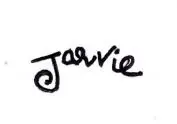Mr. Jarvie’s Famous Candlesticks

It was a tall (13.5″), slender bronze candlestick with a dark patina and a sinuous, organic form ending with the four small leaves of a flower wrapped around the top.
It was heavy, hefty and had a great feel. But there was no signature, only the casting marks left by the mold on the underside of the base.
It didn’t take much research to discover the candlestick had been designed by Robert Jarvie (1865-1941), a former clerk for the Chicago Board of Transportation. In 1900 Jarvie had set up a workshop in his home and began producing handmade lanterns and candlesticks. Encouraged by the response, in 1905, at age 40, he quit his job and became a full-time metalsmith. His wife, Lillian, worked alongside him, when she wasn’t writing children’s books.
Some of his earliest work was influenced by colonial lighting, but he soon gravitated to Art Nouveau and then to simpler Arts & Crafts designs. It was a path also being taken by such influential designers as William Grueby and Gustav Stickley.
His earliest forms, including the Art Nouveau candlestick I had discovered, were left unsigned, indicative, perhaps, of the metalsmith’s modesty. By 1903, however, Jarvie had begun advertising his work outside of Chicago and announced that in the future his work would all be signed, most often with his last name in a flowing script.
Over the course of his brief career, Robert Jarvie produced bookends, bowls, trays, humidors, wall sconces and desk accessories, but is most remembered for his extensive line of cast candlesticks. He later designed and executed a limited line of sterling silver presentation bowls and trophies. Researchers have divided his career into three phases: 1900-1905 Experimental, 1905-1912 Candlestick Production, and 1912-1917 Silver Presentation Pieces.
As it did other Arts & Crafts firms, the combined effect of World War I, the resulting shortage of raw materials and a change in public tastes led Robert Jarvie to close his workshop in 1917. At the age of 52 he went to work as a jewelry salesman. When he died in 1941, he considered himself a failure as a metalsmith.
Today, however, Robert Jarvie’s candlesticks are prized possessions among Arts & Crafts collectors. For those who want to learn more about the subtle differences among his different forms, the best reference book is The Jarvie Shop: The Candlesticks and Metalwork of Robert R. Jarvie written by Thomas K. Maher (Turn of the Century Editions, 1997).
A limited number of copies are available at http://www.turnofthecenturyeditions.com.
– Bruce Johnson
